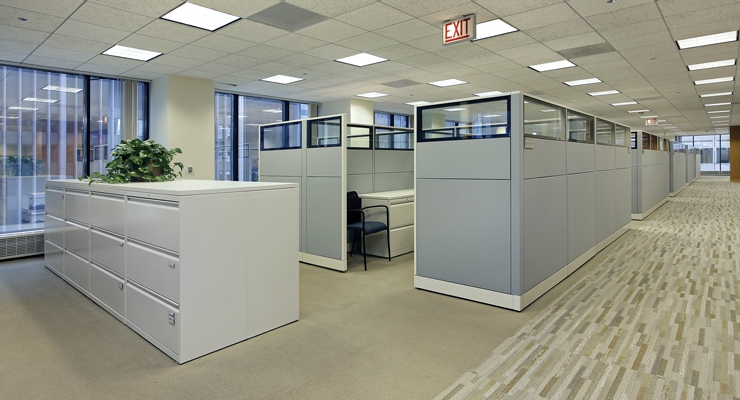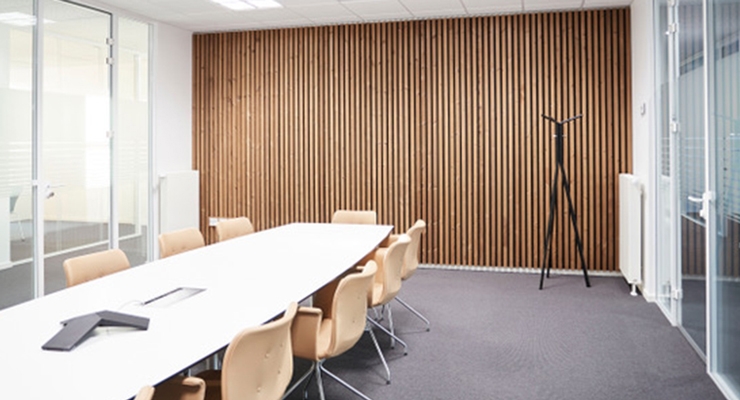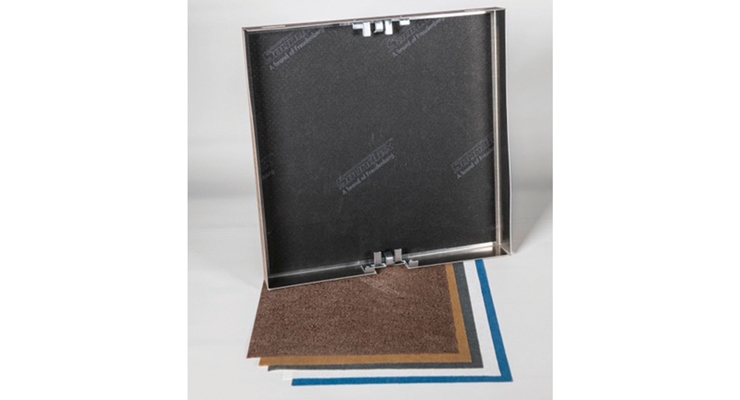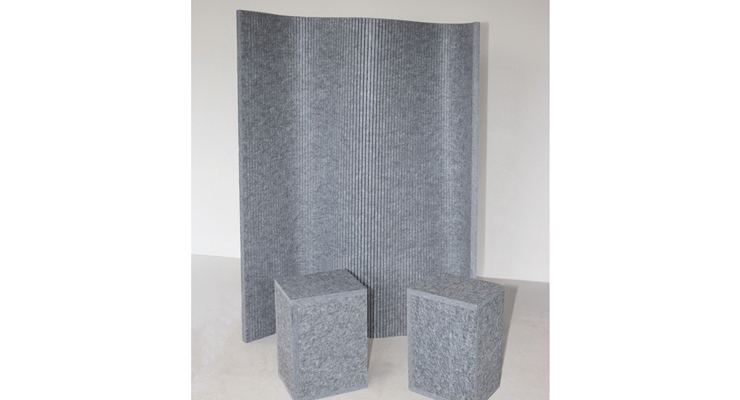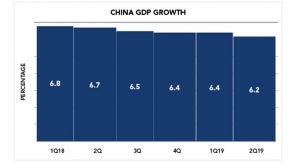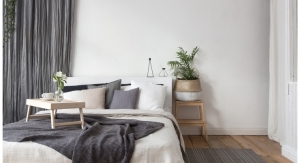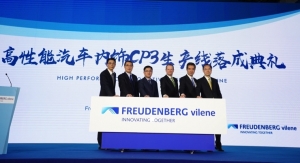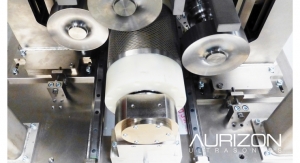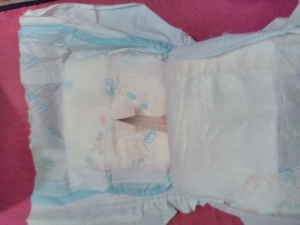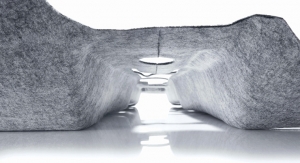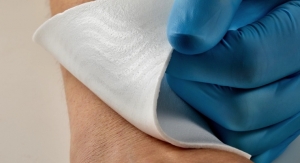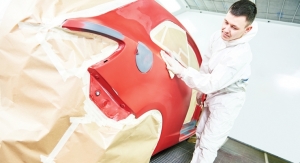Karen McIntyre, Editor03.15.19
A relatively new field for nonwovens, acoustics is expected to grow in the coming years as increased opportunities present themselves in the home interiors market and nonwovens displace competing materials in more established areas like automotives. Nonwovens will not only benefit from this consumer trend, they are also able to displace competing materials like foam or insulation thanks to their flexibility, light weight and ability to take on various shapes and sizes.
“Growth in the market for acoustic nonwovens is driven by the need for optimized interior acoustics in private homes, industrial and office spaces, as well as public buildings,” says Gerhard Klier, sales director Technical Products at Sandler. “Privacy, quietness and an environment conducive to concentration—these are the trends influencing interior design and the paramount objective is enabling people to feel comfortable. On the other hand, demand for acoustic materials is also created by increasingly stringent government guidelines and regulations on noise protection, for example applying to public buildings or schools.”
Another factor driving growth for nonwovens in this market is their suitability for further processing. A large variety of options for visual enhancement is available, from printing and embossing to lamination, or coating, for example. In this way, nonwovens bring together excellent functionality and possibilities for individual design, making them a very versatile alternative for interior acoustics.
Fibertex Nonwovens
At Fibertex Nonwovens, acoustics has emerged as an important market as the company looks to diversify into new technical areas for nonwovens. Responding to the needs for improved interior acoustics—in both workplaces and public areas—Fibertex has designed a range of sound absorbing nonwoven products which offer manufacturers, architects and specifiers, advanced acoustic performance. These high-performing acoustic materials provide the freedom to create optimal solutions, by combining noise reduction, innovative design, enhanced aesthetics and optimum comfort. The products are certified by leading quality, environmental and safety authorities.
The FiberAcoustic range consists of top quality, environmentally-friendly soundproofing materials, with excellent acoustic properties and exceptional sound absorption, for suspended ceilings, wall panels, screens and floors. Not only are they easy to install during construction or as part of a renovation, these materials are resistant to common cleaning detergents and can be vacuum cleaned, or wiped with a damp cloth. They are safe to use, with no need for a facemask or gloves. “We offer manufacturers, architects and specifiers the best acoustic performance through our unique product range supported by best-in-class product documentation,” says Marianne Brink, company spokesperson. “Our high-performing acoustics materials allow you to combine noise reduction, well-being and endless design possibilities.”
Meanwhile, in the automotive industry, Fibertex is a leading manufacturer and its product participates to the acoustic performance. Its heavyweight, needled PET fabric used in molded wheel arches, reduce tire noise and its automotive interior floor backing plays an acoustic role due to its thickness and open fiber structure.
Freudenberg Performance Materials
Freudenberg’s SoundTex is a thin acoustic nonwoven that enables perforated structures to absorb sound. It is used extensively in a number of applications where acoustics are a prime consideration for either artistic or purely functional reasons. Typical examples include airports, office buildings, municipal halls, theaters, convention centers, subway stations, partitions and furniture in offices all over the world.
With a porous sound absorber like SoundTex, sound energy is changed into thermal energy by viscous friction. Furthermore, the ultra-thin profile of the acoustic nonwoven makes handling and installation easy. By means of heat and pressure, it is easily laminated onto all perforated elements directly at the factory, reducing shipping costs, workload and complexity at the construction site.
Its extreme thinness provides architects and designers with maximum flexibility while reducing shipping and storage costs at the same time.
SoundTex can be supplied in roll or sheet form, eliminating the need for manual cutting and fitting. This feature also allows greater use of automated production processes.
Acoustic nonwovens are air-permeable and do not interfere with certain ventilation processes. This feature provides architects and designers with greater flexibility in positioning air inlets and vents. Even applications involving heating and cooling systems have proved to be very efficient.
An additional benefit is the global presence of Freudenberg Performance Materials, which enables the company to deliver SoundTex according to individual customer requirements within a short time. This global infrastructure is a very valuable aspect as speed of delivery is a particularly important parameter in the construction industry. This has also allowed Freudenberg to be a global partner for acoustic applications in the construction industry.
“All well-known manufacturers worldwide primarily use our SoundTex acoustic nonwoven fabric for perforated metal ceiling systems,” says Katrin Böttcher, manager media relations at Freudenberg Performance Materials. “Our worldwide presence allows us to respond with customized solutions at short notice. If these ceiling systems are designed as heating and cooling ceilings, Freudenberg’s SoundTex is the first choice in Europe.”
In addition, this acoustic nonwoven is used for other sound-absorbing measures in the interior sector, e.g. for perforated partition walls and furniture in offices. Certifications and test reports for all relevant markets worldwide allow the use of Freudenberg’s acoustic nonwoven in all new buildings or revitalization measures, e.g. airports, offices, shopping malls, etc.
SoundTex was recently used in Hamburg, Germany, at the Elbphilharmonie. The building’s acoustic requirements were immense, right from the start – not just in the concert halls but also in the foyers, where SoundTex ensures that harmony prevails, Böttcher says.
It was a project full of architectural corners, edges, slopes and curves. The Lindner Group, Europe’s leading specialist in the areas of interior design, facade construction and insulation technology, laboriously installed around 700 square meters of ceiling area and more than 400 square meters of wall in the “Elphi.” The ceiling was cladded with an UV-varnished real wood veneer made from coco oak, the Lindner product FIREwood A2 classic acoustic.
The acoustic goal for the foyers was to reduce the high level of noise generated by the combination of reverberative glass and wood surfaces and the excited babble of visitors’ voices. Thanks to its high sound absorption values, SoundTex acoustic nonwoven was an ideal fit for the product, she adds.
Sandler
Sandler has supplied acoustically efficient nonwovens for several decades, providing it with substantial know-how in technologies, product properties and areas of application. Deep knowledge in acoustics enables the company to provide advice and propose the right material for requested application.
Describing its nonwovens as voluminous and soft, Sandler uses them as insulation materials in construction or technical insulation where they compete against glass wool or mineral wool materials as well as other insulation materials such as polystyrene or foam. Self-supporting, dimensionally stable product variants are used in acoustic room elements such as wall- or ceiling-systems, partitions, acoustic wall decoration or even acoustic furniture. Sandler nonwovens are also applied as absorbers in the automotive industry.
“Utilizing our expertise in different production technologies, Sandler can adjust product properties to ideally fit the requirements of the specific application. In this way, we utilize the versatility of nonwovens to provide the high-quality solutions for diverse applications in acoustics,” says Klier.
Sandler acoustic materials feature an open-pore structure, in which fine fibers create a more or less flexible “fiber skeleton” with a large inner surface. Sound waves are absorbed and dampened by the nonwoven. These materials are manufactured using thermal bonding using 100% polyester—the same fibers also used in clothing. Depending on the target application, at least 30% of the utilized polyester fibers are recycled, produced from bottle flakes. Being single-polymer materials, the nonwovens are fully recyclable themselves. “In this way, we manufacture high-quality products that support closed material cycles and contribute to conserving resources,” Klier adds. “Nevertheless, other polymers or even natural fibers could also be used to manufacture acoustically efficient nonwovens, further expanding the range of materials for these applications.”
In Sandler’s view, nonwovens’ open pore structure makes them ideal for acoustics. “This renders them ideal sound insulators, but also efficient heat insulators. Nonwovens offer many possibilities to adjust product properties such as thickness and volumetric weight to fulfil individual product requirements,” Klier adds.
Sandler nonwovens are lightweight, easy to handle and manufactured without any chemical binders or additives. As such, these materials are gentle on the skin and odorless. Flame-resistant product variants are also available. Being made from polyester, Sandler’s nonwovens for acoustics are resistant to aging and rotting, moisture and UV light, and offer no breeding grounds for germs or bacteria. All-in-all, they fulfill the highest requirements on product safety, health and durability and provide an optimum alternative for people suffering from allergies.
Meanwhile, interior design—with regard to both workplaces and living spaces—increasingly focuses on open-plan layouts. Creating a sense of spaciousness and open, light-filled spaces are at the center of attention. At home, but probably to a larger extent at the workplace, it is vital to combine this openness with a quiet atmosphere—to provide a quiet place of relaxation or enable people to concentrate on their work, respectively. Bringing these two, seemingly contradictory, objectives together created the need for acoustically efficient interior design elements. Partitions, panels suspended from the ceiling, acoustically efficient wall decoration and acoustic furniture dampen sound, but are also used as design elements.
The automotive market is also providing significant growth for nonwovens manufacturers involved in acoustics. Highly efficient absorber nonwovens continue to provide excellent sound insulation in vehicles—from cars, to trucks, trains, and even airplanes. “Only a few years ago nonwovens, especially based on synthetic fibers, were used mainly for interior applications,” Klier says. “Absorber nonwovens in door panels and many other components dampen engine and driving noise, creating pleasant acoustics in the cabin and contributing to a comfortable drive.”
In addition, new mobility concepts bring about new requirements on the utilized materials. For example, the noise level in electric cars is different to that of cars with combustion engines. Therefore, new materials are in high demand. Driverless vehicles are meant to enable passengers to use the time on the road for other tasks, without having to concentrate on traffic. Sound absorbers will have to insulate road noise even more efficiently and making the drive comfortable will be more important than ever.
“Growth in the market for acoustic nonwovens is driven by the need for optimized interior acoustics in private homes, industrial and office spaces, as well as public buildings,” says Gerhard Klier, sales director Technical Products at Sandler. “Privacy, quietness and an environment conducive to concentration—these are the trends influencing interior design and the paramount objective is enabling people to feel comfortable. On the other hand, demand for acoustic materials is also created by increasingly stringent government guidelines and regulations on noise protection, for example applying to public buildings or schools.”
Another factor driving growth for nonwovens in this market is their suitability for further processing. A large variety of options for visual enhancement is available, from printing and embossing to lamination, or coating, for example. In this way, nonwovens bring together excellent functionality and possibilities for individual design, making them a very versatile alternative for interior acoustics.
Fibertex Nonwovens
At Fibertex Nonwovens, acoustics has emerged as an important market as the company looks to diversify into new technical areas for nonwovens. Responding to the needs for improved interior acoustics—in both workplaces and public areas—Fibertex has designed a range of sound absorbing nonwoven products which offer manufacturers, architects and specifiers, advanced acoustic performance. These high-performing acoustic materials provide the freedom to create optimal solutions, by combining noise reduction, innovative design, enhanced aesthetics and optimum comfort. The products are certified by leading quality, environmental and safety authorities.
The FiberAcoustic range consists of top quality, environmentally-friendly soundproofing materials, with excellent acoustic properties and exceptional sound absorption, for suspended ceilings, wall panels, screens and floors. Not only are they easy to install during construction or as part of a renovation, these materials are resistant to common cleaning detergents and can be vacuum cleaned, or wiped with a damp cloth. They are safe to use, with no need for a facemask or gloves. “We offer manufacturers, architects and specifiers the best acoustic performance through our unique product range supported by best-in-class product documentation,” says Marianne Brink, company spokesperson. “Our high-performing acoustics materials allow you to combine noise reduction, well-being and endless design possibilities.”
Meanwhile, in the automotive industry, Fibertex is a leading manufacturer and its product participates to the acoustic performance. Its heavyweight, needled PET fabric used in molded wheel arches, reduce tire noise and its automotive interior floor backing plays an acoustic role due to its thickness and open fiber structure.
Freudenberg Performance Materials
Freudenberg’s SoundTex is a thin acoustic nonwoven that enables perforated structures to absorb sound. It is used extensively in a number of applications where acoustics are a prime consideration for either artistic or purely functional reasons. Typical examples include airports, office buildings, municipal halls, theaters, convention centers, subway stations, partitions and furniture in offices all over the world.
With a porous sound absorber like SoundTex, sound energy is changed into thermal energy by viscous friction. Furthermore, the ultra-thin profile of the acoustic nonwoven makes handling and installation easy. By means of heat and pressure, it is easily laminated onto all perforated elements directly at the factory, reducing shipping costs, workload and complexity at the construction site.
Its extreme thinness provides architects and designers with maximum flexibility while reducing shipping and storage costs at the same time.
SoundTex can be supplied in roll or sheet form, eliminating the need for manual cutting and fitting. This feature also allows greater use of automated production processes.
Acoustic nonwovens are air-permeable and do not interfere with certain ventilation processes. This feature provides architects and designers with greater flexibility in positioning air inlets and vents. Even applications involving heating and cooling systems have proved to be very efficient.
An additional benefit is the global presence of Freudenberg Performance Materials, which enables the company to deliver SoundTex according to individual customer requirements within a short time. This global infrastructure is a very valuable aspect as speed of delivery is a particularly important parameter in the construction industry. This has also allowed Freudenberg to be a global partner for acoustic applications in the construction industry.
“All well-known manufacturers worldwide primarily use our SoundTex acoustic nonwoven fabric for perforated metal ceiling systems,” says Katrin Böttcher, manager media relations at Freudenberg Performance Materials. “Our worldwide presence allows us to respond with customized solutions at short notice. If these ceiling systems are designed as heating and cooling ceilings, Freudenberg’s SoundTex is the first choice in Europe.”
In addition, this acoustic nonwoven is used for other sound-absorbing measures in the interior sector, e.g. for perforated partition walls and furniture in offices. Certifications and test reports for all relevant markets worldwide allow the use of Freudenberg’s acoustic nonwoven in all new buildings or revitalization measures, e.g. airports, offices, shopping malls, etc.
SoundTex was recently used in Hamburg, Germany, at the Elbphilharmonie. The building’s acoustic requirements were immense, right from the start – not just in the concert halls but also in the foyers, where SoundTex ensures that harmony prevails, Böttcher says.
It was a project full of architectural corners, edges, slopes and curves. The Lindner Group, Europe’s leading specialist in the areas of interior design, facade construction and insulation technology, laboriously installed around 700 square meters of ceiling area and more than 400 square meters of wall in the “Elphi.” The ceiling was cladded with an UV-varnished real wood veneer made from coco oak, the Lindner product FIREwood A2 classic acoustic.
The acoustic goal for the foyers was to reduce the high level of noise generated by the combination of reverberative glass and wood surfaces and the excited babble of visitors’ voices. Thanks to its high sound absorption values, SoundTex acoustic nonwoven was an ideal fit for the product, she adds.
Sandler
Sandler has supplied acoustically efficient nonwovens for several decades, providing it with substantial know-how in technologies, product properties and areas of application. Deep knowledge in acoustics enables the company to provide advice and propose the right material for requested application.
Describing its nonwovens as voluminous and soft, Sandler uses them as insulation materials in construction or technical insulation where they compete against glass wool or mineral wool materials as well as other insulation materials such as polystyrene or foam. Self-supporting, dimensionally stable product variants are used in acoustic room elements such as wall- or ceiling-systems, partitions, acoustic wall decoration or even acoustic furniture. Sandler nonwovens are also applied as absorbers in the automotive industry.
“Utilizing our expertise in different production technologies, Sandler can adjust product properties to ideally fit the requirements of the specific application. In this way, we utilize the versatility of nonwovens to provide the high-quality solutions for diverse applications in acoustics,” says Klier.
Sandler acoustic materials feature an open-pore structure, in which fine fibers create a more or less flexible “fiber skeleton” with a large inner surface. Sound waves are absorbed and dampened by the nonwoven. These materials are manufactured using thermal bonding using 100% polyester—the same fibers also used in clothing. Depending on the target application, at least 30% of the utilized polyester fibers are recycled, produced from bottle flakes. Being single-polymer materials, the nonwovens are fully recyclable themselves. “In this way, we manufacture high-quality products that support closed material cycles and contribute to conserving resources,” Klier adds. “Nevertheless, other polymers or even natural fibers could also be used to manufacture acoustically efficient nonwovens, further expanding the range of materials for these applications.”
In Sandler’s view, nonwovens’ open pore structure makes them ideal for acoustics. “This renders them ideal sound insulators, but also efficient heat insulators. Nonwovens offer many possibilities to adjust product properties such as thickness and volumetric weight to fulfil individual product requirements,” Klier adds.
Sandler nonwovens are lightweight, easy to handle and manufactured without any chemical binders or additives. As such, these materials are gentle on the skin and odorless. Flame-resistant product variants are also available. Being made from polyester, Sandler’s nonwovens for acoustics are resistant to aging and rotting, moisture and UV light, and offer no breeding grounds for germs or bacteria. All-in-all, they fulfill the highest requirements on product safety, health and durability and provide an optimum alternative for people suffering from allergies.
Meanwhile, interior design—with regard to both workplaces and living spaces—increasingly focuses on open-plan layouts. Creating a sense of spaciousness and open, light-filled spaces are at the center of attention. At home, but probably to a larger extent at the workplace, it is vital to combine this openness with a quiet atmosphere—to provide a quiet place of relaxation or enable people to concentrate on their work, respectively. Bringing these two, seemingly contradictory, objectives together created the need for acoustically efficient interior design elements. Partitions, panels suspended from the ceiling, acoustically efficient wall decoration and acoustic furniture dampen sound, but are also used as design elements.
The automotive market is also providing significant growth for nonwovens manufacturers involved in acoustics. Highly efficient absorber nonwovens continue to provide excellent sound insulation in vehicles—from cars, to trucks, trains, and even airplanes. “Only a few years ago nonwovens, especially based on synthetic fibers, were used mainly for interior applications,” Klier says. “Absorber nonwovens in door panels and many other components dampen engine and driving noise, creating pleasant acoustics in the cabin and contributing to a comfortable drive.”
In addition, new mobility concepts bring about new requirements on the utilized materials. For example, the noise level in electric cars is different to that of cars with combustion engines. Therefore, new materials are in high demand. Driverless vehicles are meant to enable passengers to use the time on the road for other tasks, without having to concentrate on traffic. Sound absorbers will have to insulate road noise even more efficiently and making the drive comfortable will be more important than ever.

